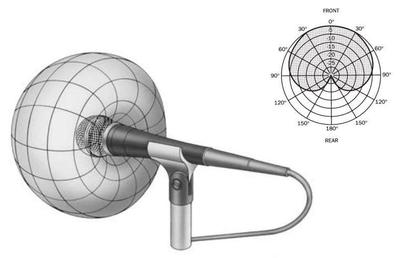Microphone response patterns
Microphone response patterns, or “where’s that noise coming from?”
Microphones have something called a polar response pattern. This describes from what directions a microphone will pick up noise.
There are two main response patterns that we are interested in…
- OMNI-DIRECTIONAL
- CARDIOID
Omni-directional
- These microphones pick up sound from every direction
- The closer you are to the microphone the louder you will sound …and naturally the louder you sound, the quieter (by comparison) any background noise will be
- These kinds of microphone can be found in a conference-telephone,or in a LAVALIER (lapel) microphone
- A lavalier microphone relies on being very close to your mouth
Cardioid
- These microphones pick up sound from IN FRONT, but not so much from the sides or behind
- The closer you are to the microphone the louder you will sound, but you do not need to rely so much on proximity
- The microphone naturally focuses on the sound of your voice, as long as you are in front of it
Here is a hand-held vocal microphone which has been attached to a stand. The ‘bubble’ around is a representation of where the microphone is most sensitive to sound.

Cutting through the marketing… what you really interested
For recording audio at home there has been a huge push to consumers to create low cost large diaphragm condenser microphones. Microphones such as the Blue Yeti have become incredibly popular with podcasters. Large condenser mics usually have polar pickup patterns that allow some sound from behind the microphone to be recorded. In a home setting this may be the sound of your mouse or keyboard, or splash reverb from your computer monitor (a large flat reflective surface), or noise from outside of the house or office.
A dynamic micrphone has non of these problems. Dynamic mics are hard wearing (they can even survive being dropped on the floor), and with a cardioid pickup they are easily the best choice for many voice artists. Two professional choices are the Shure SM7B and the Electro-Voice RE20. Both are frequently used in professional broadcast applications such as radio. A lower cost mic with a similar application and build quality is the Rode ProCaster. All of these dynamic mics are “hard to drive” and to get the best out of them you will require a mic pre booster such as this one from Marti Audio or the popular but expensive Cloud Lifter. You will also need a USB audio interface with phantom power and a good mic amp, such as the Audient iD14. There are many review and comparison sites to do further research into USB audio interfaces however the important factor is the quality of the mic amp.
In short this site recommends:
- Purchase a high quality dynamic mic designed for broadcast use
- Use a USB audio interface with phantom power and high quality micrphone amps
- Purchase a micrphone pre amp booster